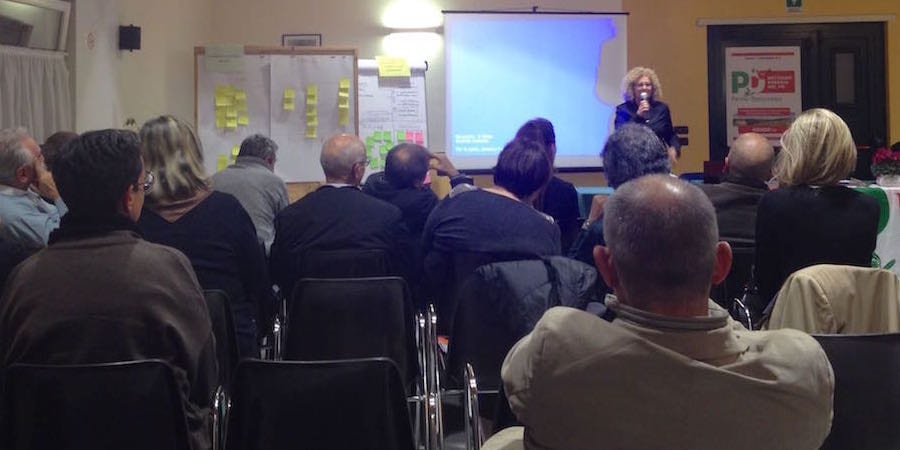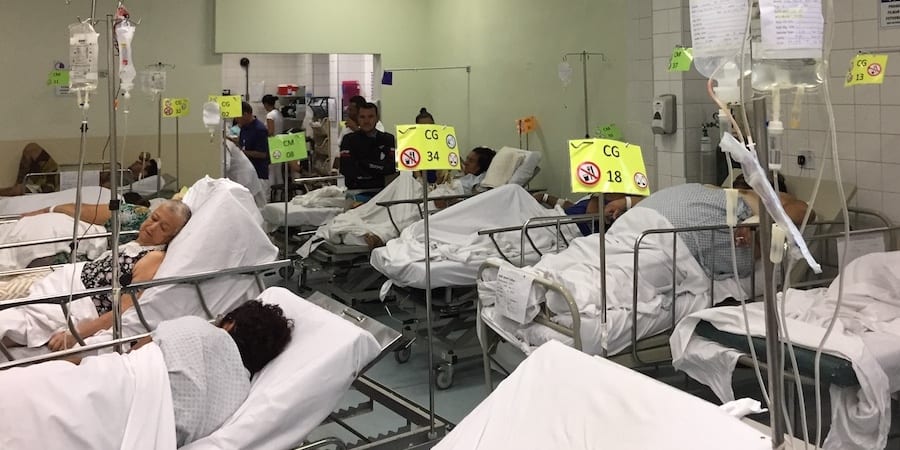
A political party's first steps towards lean thinking
FEATURE – A local branch of Italy’s Democratic Party has started using lean principles and tools to organize its activities more effectively and to counteract the discouragement that followed a bad electoral defeat.
Words: Roberto Ronzani, CEO, Istituto Lean Management
Voters in the 2015 regional election in Italy dealt a massive blow to the center-left Partito Democratico in the city of Vicenza. Not only did the party fail to win the region’s presidency – its candidate, Vicenza-born Alessandra Moretti, gained just 22.7% of the votes – but it also reached a mere 13.8% in the Vicenza province, four points down from the previous election in 2010.
The sense of disillusionment that this defeat created made it even more difficult for the local branch of the Partito Democratico (PD) to focus on its activities. In a bid to change things, the branch embarked on a journey towards quicker, more meaningful, and focused work.
In Italy (but I am sure this is true in other countries as well) people tend to think that a political party’s internal activities aren’t very effective – not to menion efficient – and that they mainly consist of endless and often inconclusive meetings. Decisions are often made unilaterally by leadership; they are driven by short-sighted opportunism rather than the idea of “doing the right thing;” and all too often they are largely influenced by feuds between internal political currents when powerful positions are up for grabs.
A top leader of the local branch of the party told me: “The current way our party is organized is good for communicating decisions made at the top, not for deciding together, but you can’t keep acting in the same way and expect different results! It was clear there was something wrong about our decision-making process.”
A natural consequence of such dynamics (which we see at play in businesses as well) is that when the Vicenza branch of the PD was faced with the electoral defeat the finger-pointing quickly followed, while motivation among members sank to an all time low.
Attempts to breathe new life into the organization by establishing “working groups” on important topics didn’t prove successful, the reason being that these were organized in a traditional way.
This inpasse led the provincial directorate of the party to reach out to the Istituto Lean Management. We were immediately intrigued by this challenge, but could lean help a political organization to get out of such a difficult situation?
SCIENCE DOES IT

We started by wondering how we could approach the problem scientifically and tried to understand what “measuring the gap” – in this case, lack of motivation – meant in this specific context.
The answer appeared to be rather simple: motivation can be measured indirectly using as a metric the ability to work and solve problems together (as a team) in a certain period of time.
Our analysis of a number of the party’s meetings showed that the dynamics were actually very similar to those that we routinely observe in the companies we work with: each participant tends to have a different opinion; they speak about assumptions rather than facts; they fail to use any form of non-verbal communication (no visuality); nobody respects the time given to them; and the meeting typically ends with no notes taken and no decisions made.
Drawing our inspiration from Lean Transformation Framework, we encouraged participants to use visual management to express their opinion on the good and the bad in their organization – a sort of pros and cons, with green post-it notes used to indicate pros and orange post-it notes to indicate the cons.
Attributing the post-it notes to each of the five elements of the Framework (situational approach; process improvement; people development; leadership and management system; and underlying assumptions) the group was able to identify four main criticalities:
- The identity of the Partito Democratico in the Veneto region (basic thinking);
- The relationship between the Provincial Branch of the Party and its local circles (process);
- The organization and structure of the branch of the Party and its relationship with local administration (again, process);
- The party’s interaction with society, mainly social and economic interest groups (value-driven purpose).
The group then broke into four working sub-groups. Each of them focused on one of the issues using A3 thinking to try and tackle them.
WHAT THEY ACHIEVED
In those groups that didn’t apply the lean approach, the modus operandi stayed the same, which resulted in detachment from the problems assigned, a lack of quantitative analysis, and vague objectives. The groups that embraced lean and applied it in earnest, however, saw far better results: through A3 thinking they were able to stay focused on the issues they were tackling and carried out solid analysis. More importantly, they set concrete goals for the party and came up with potential ways to reach them. Interestingly, the members of the working groups that had enthusiastically used lean also said that work had become more pleasant.
Some of the agreed-upon countermeasures identified thanks to A3 problem solving included: opening channels of communication between provincial party leadership and local circles; periodically provide education to party members and leaders; and ringfence time to consult party members (aka citizens) on their needs, opinions and expectations.

At the end of this experiment, the projects the sub-groups had come up with were presented to the Provincial Assembly (the governing body of the party’s local branch), which approved them.
Just like in industry, the successful implementation of lean thinking in the Partito Democratico in Vicenza depended on the skills and buy-in of leadership. Party leaders have expressed their intention to perservere and to keep using lean, working hard to implement the decisions made and to convince the skeptics until the methodology becomes the default way of operating. They are also considering ways to use lean to improve alignment within the party.
Lean thinking can provide a political party (just like any other organization) with a scientific approach to guiding discussions and organizing work, which leads to efficiency – by eliminating non-value adding discussions – and effectiveness – by helping to do the right things and to do them well.
Local party leaders commented on this initial, but successful experiment saying: “This is a very innovative approach for a political party. To make decisions based on data rather than opinion is no easy exercise! However, people have given us a mandate to make decisions for them on how to use public money, how to deliver services and how to improve the way we live together as a society. The least we can do is finding an effective and efficient way to do so!”
THE AUTHOR

Read more


FEATURE – The importance of leveraging early successes to drive engagement to lean is often talked about. The story of this Brazilian hospital confirms this is the way to go.


FEATURE – This article shares the lean journeys of four North American hospitals, and their learning's, reminding us that being part of a network of likeminded practitioners is critical to our success.


INTERVIEW - Pierre Masai, CIO of Toyota Motor Europe, discusses IT across the company's operations in Europe, highlighting the importance of people engagement and experiments.


CASE STUDY – Lean thinking is transforming San Diego Zoo Global, helping this century-old organization provide a better experience to its visitors and a better life to its animals.

